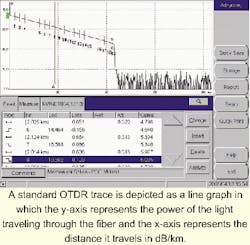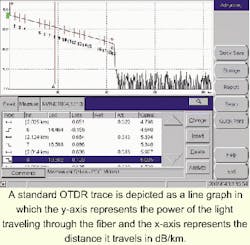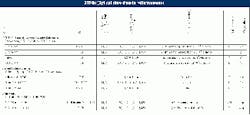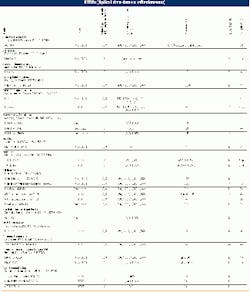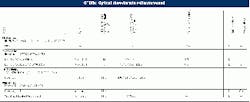OTDR market defined by end-user demand
BY MEGHAN FULLER
Five minutes after the door opened and OFC 2001 (Anaheim, CA) officially began, I found myself face to face with an optical time-domain reflectometer (OTDR). Jet-lagged and somewhat overwhelmed by my first glimpse around the show floor, even I could operate the device. My experience illustrates the biggest trend in the manufacturing of OTDRs and test equipment in general: Make it easier, faster, lighter, more efficient, and cost-effective.
OTDRs are used to test or characterize fiber-optic cables and, by extension, entire fiber-optic networks with a single-end test. They measure overall end-to-end loss, section loss, and splice loss, as well as the reflectance of connectors and mechanical splices. They are used to locate breaks, defects, and misalignments and any gradual or sudden degradation of the fiber.
An OTDR transmits thousands of short light pulses across the fiber every second. Optical fiber is subject to attenuation loss, measured in dB/km. Such loss is wavelength-dependent. At 1,550 nm, the loss is 0.18 to 0.2 dB/km; at 1,310 nm, the loss is 0.33 to 0.35 dB/km. An OTDR calculates this loss by measuring the amount of light reflected back to the transmitter, known as Rayleigh backscattering.
OTDRs also measure Fresnel reflection, which occurs when there is an abrupt change in the index of refraction. At splice points, when the light signal travels from fiber to air back into fiber-even if it's just for a millimeter-as much as 4% of that signal is reflected back. With an OTDR, you can see the reflection, determine its point of origin, and calculate the loss.
On most OTDRs, the loss is measured using a graph known as a trace (see Figure). The y-axis describes the power of the signal while the x-axis represents the distance it travels in dB/km. As a signal travels across the fiber, it continually loses power due to standard attenuation. "In pure, pristine fiber, that would just have a nice, gradual downward slope because you have some attenuation in the fiber, and the light has traveled out some distance and come back," explains Michael Reunert, product-line marketing manager for Tektronix Inc.'s (Beaverton, OR) optical installation and maintenance division. "The longer in time you wait, the longer distance the light has traveled, the more attenuation or loss there will be."
"By looking at the timing and measuring the speed of the light, you can now know how long the fiber is," adds Reunert. "You can also measure the total loss, from end to end, just by looking at the y coordinates at the beginning of the trace and looking at how far down on the y-axis it's dropped by the time you get to the end of the fiber."
Today's OTDRs are beginning to test other parameters as well, including chromatic dispersion, or the spreading of an optical signal. "Chromatic dispersion becomes very critical when you are looking at very high-speed transmission, like OC-192 and be-yond," explains Graham Sperrin, product marketing manager at Anritsu Co. (Richardson, TX). Previously installed fiber may not have been qualified for this parameter, he says, which presents a problem; fiber installers must somehow compensate for the dispersion, and they can't do that unless they can measure it.
There has also been a gradual increase in the dynamic range, or how far and how fast you can test with an OTDR. "The challenge is trying to find the detectors or the lasers or the electronics or the OTDR algorithm that will actually allow you to see further down the line," contends Stéphane Chabot, business unit manager for outside plant products at EXFO Engineering Inc. (Vanier, Quebec). "The farther you can see, the farther you can test, the farther you can maintain."The biggest trend in the OTDR market, however, is ease of use. Tens of thousands of OTDRs are currently in use throughout the world, says Reunert, and, "after a while, it gets harder and harder to find 10,000 or 100,000 operators who really understand all the technical ins and outs of how the instrument works." Manufacturers have built in all sorts of functions to ensure that even the layman can achieve accurate measurements. Some have even created fully automated, one-button devices, and the display screens are designed to be as intuitive as possible.
"The last thing you want is for someone to go out and have difficulty with the instrument or, even worse, bring back bad data, because then you have to go back and do it all over again," asserts Reunert.
The speed of OTDRs has also improved, particularly for testing high-fiber-count cables. "When you do a bidirectional test on an 864-fiber cable, you are talking about 864 tests in one direction, 864 tests in the other direction, and then you have to do that at multiple wavelengths-1,625, 1,550, and 1,310 nm," explains Larry Crossett, product marketing manager at GN Nettest (Utica, NY). "The installer could spend a lot of time testing, so one of the features customers are looking for is speed." In the past, OTDRs took between 30 sec and 3 minutes to characterize a fiber. Today, the devices take 10 to 15 sec for the entire acquisition.
Fiber installers are also looking for the ability to store large quantities of data in their OTDRs, which goes hand in hand with the ability to do remote testing. "Fiber installers want to be able to store a maximum amount of files in the unit-they want a huge amount of memory," asserts Gregory Lietaert, OTDR product manager at Acterna (Germantown, MD). "They also want to be able to send all the files immediately to the expert or leader for him to generate the commissioning report to give to the end customer."
Reunert agrees. "In the end, people don't really care about the instrument," he says. "What they care about is the data."
Another trend in the market is the ability to test multiple fibers at the same time. The solution, says Chabot, is to combine an OTDR with an optical switch to automate the testing sequence. Plugging and testing one fiber after another could take days but, explains Chabot, "if you can test 12 fibers at the same time-or at least connect all of them, do the testing, and save all the files at the same time-[the end user] will save time."
Optical switches are also used in conjunction with OTDRs embedded in remote fiber test systems, which typically sit in central offices and are in constant operation. "Those companies that would like to achieve a quality of service of 99.999% or those who have service-level agreements that guarantee they will be able to repair any fault on a network in under four hours use these systems," says Chabot.
The advent of DWDM has led to the need to test at different wavelengths, which is critical because each wavelength exhibits different loss. Manufacturers are now shipping OTDRs designed to operate in the L-band, or the 1,600-nm window, which features longer wavelengths. "Had you tested your fiber at, say, 1,310 or 1,550, and then you started sending L-band traffic, which is up over 1,600 nm, you might have seen very different results, because it is so much more sensitive to bending. You would have seen a lot more loss," explains Reunert.
OTDRs are also moving into the S-band, but testing there is trickier due to its increased sensitivity to the water peak, which results in high attenuation. However, the recent release of new fibers from Corning, Lucent, and others has buoyed this effort tremendously. Through the manufacturing process, they have found a way to reduce the water peak to a point where it is nearly non-existent. "The attenuation was going extremely high, over 1 dB/km," says Chabot. "The new fiber reduces attenuation to around 0.31 dB in that transmission window. It's a breakthrough."
There is still a need to test in this range, though, as Sperrin explains. "With time, if water gets into the fiber, that peak could grow," he says.
While some manufacturers do have S-band-capable OTDRs in production, they are still very much in their infancy. "We don't know what the industry standard [for the S-band] is going to be," explains Reunert. "But we're working closely with suppliers of components and WDM systems to see what the midpoint might be that our customers would test at."
OTDR manufacturers are also faced with the complexity of testing point-to-multipoint passive optical networks. "Whatever the company is, say Bell Atlantic, they actually transmit into one of their rings, and then the signal is split in two, then split in two again, and again to reach a business area where they have 30 users out there," explains Chabot. "But it's bidirectional; it's transmit and receive going to all of those users. All that reflection is coming back at the same time from all those mini-segments to the same transmitter." It presents a unique problem for OTDR manufacturers; many are currently working on a solution.
Despite the anticipated downturn in the market, OTDR manufacturers remain optimistic-and with good reason. Market-research firm ElectroniCast Corp. (San Mateo, CA) expects the total global consumption of OTDRs to grow from $1.9 billion in 1999 to more than $3.6 billion by 2003.For the foreseeable future, the OTDR market is and will continue to be healthy. "As long as you have fiber installed and as long as you are installing new fiber, you will need OTDRs," says Crossett.
